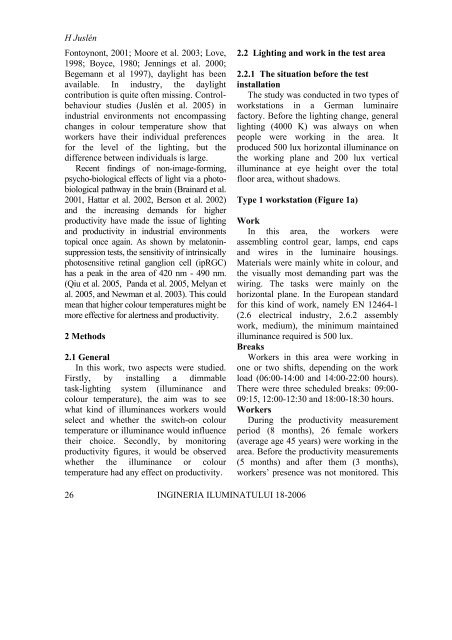This issue is sponsored by the Philips Romania, Lighting Division
This issue is sponsored by the Philips Romania, Lighting Division
This issue is sponsored by the Philips Romania, Lighting Division
You also want an ePaper? Increase the reach of your titles
YUMPU automatically turns print PDFs into web optimized ePapers that Google loves.
H Juslén<br />
Fontoynont, 2001; Moore et al. 2003; Love,<br />
1998; Boyce, 1980; Jennings et al. 2000;<br />
Begemann et al 1997), daylight has been<br />
available. In industry, <strong>the</strong> daylight<br />
contribution <strong>is</strong> quite often m<strong>is</strong>sing. Controlbehaviour<br />
studies (Juslén et al. 2005) in<br />
industrial environments not encompassing<br />
changes in colour temperature show that<br />
workers have <strong>the</strong>ir individual preferences<br />
for <strong>the</strong> level of <strong>the</strong> lighting, but <strong>the</strong><br />
difference between individuals <strong>is</strong> large.<br />
Recent findings of non-image-forming,<br />
psycho-biological effects of light via a photobiological<br />
pathway in <strong>the</strong> brain (Brainard et al.<br />
2001, Hattar et al. 2002, Berson et al. 2002)<br />
and <strong>the</strong> increasing demands for higher<br />
productivity have made <strong>the</strong> <strong><strong>is</strong>sue</strong> of lighting<br />
and productivity in industrial environments<br />
topical once again. As shown <strong>by</strong> melatoninsuppression<br />
tests, <strong>the</strong> sensitivity of intrinsically<br />
photosensitive retinal ganglion cell (ipRGC)<br />
has a peak in <strong>the</strong> area of 420 nm - 490 nm.<br />
(Qiu et al. 2005, Panda et al. 2005, Melyan et<br />
al. 2005, and Newman et al. 2003). <strong>Th<strong>is</strong></strong> could<br />
mean that higher colour temperatures might be<br />
more effective for alertness and productivity.<br />
2 Methods<br />
2.1 General<br />
In th<strong>is</strong> work, two aspects were studied.<br />
Firstly, <strong>by</strong> installing a dimmable<br />
task-lighting system (illuminance and<br />
colour temperature), <strong>the</strong> aim was to see<br />
what kind of illuminances workers would<br />
select and whe<strong>the</strong>r <strong>the</strong> switch-on colour<br />
temperature or illuminance would influence<br />
<strong>the</strong>ir choice. Secondly, <strong>by</strong> monitoring<br />
productivity figures, it would be observed<br />
whe<strong>the</strong>r <strong>the</strong> illuminance or colour<br />
temperature had any effect on productivity.<br />
26<br />
2.2 <strong>Lighting</strong> and work in <strong>the</strong> test area<br />
2.2.1 The situation before <strong>the</strong> test<br />
installation<br />
The study was conducted in two types of<br />
workstations in a German luminaire<br />
factory. Before <strong>the</strong> lighting change, general<br />
lighting (4000 K) was always on when<br />
people were working in <strong>the</strong> area. It<br />
produced 500 lux horizontal illuminance on<br />
<strong>the</strong> working plane and 200 lux vertical<br />
illuminance at eye height over <strong>the</strong> total<br />
floor area, without shadows.<br />
Type 1 workstation (Figure 1a)<br />
INGINERIA ILUMINATULUI 18-2006<br />
Work<br />
In th<strong>is</strong> area, <strong>the</strong> workers were<br />
assembling control gear, lamps, end caps<br />
and wires in <strong>the</strong> luminaire housings.<br />
Materials were mainly white in colour, and<br />
<strong>the</strong> v<strong>is</strong>ually most demanding part was <strong>the</strong><br />
wiring. The tasks were mainly on <strong>the</strong><br />
horizontal plane. In <strong>the</strong> European standard<br />
for th<strong>is</strong> kind of work, namely EN 12464-1<br />
(2.6 electrical industry, 2.6.2 assembly<br />
work, medium), <strong>the</strong> minimum maintained<br />
illuminance required <strong>is</strong> 500 lux.<br />
Breaks<br />
Workers in th<strong>is</strong> area were working in<br />
one or two shifts, depending on <strong>the</strong> work<br />
load (06:00-14:00 and 14:00-22:00 hours).<br />
There were three scheduled breaks: 09:00-<br />
09:15, 12:00-12:30 and 18:00-18:30 hours.<br />
Workers<br />
During <strong>the</strong> productivity measurement<br />
period (8 months), 26 female workers<br />
(average age 45 years) were working in <strong>the</strong><br />
area. Before <strong>the</strong> productivity measurements<br />
(5 months) and after <strong>the</strong>m (3 months),<br />
workers’ presence was not monitored. <strong>Th<strong>is</strong></strong>
















